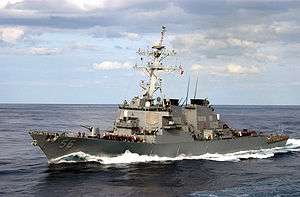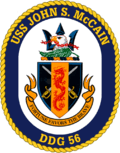USS John S. McCain (DDG-56)
 USS John S. McCain (DDG-56) | |
| History | |
|---|---|
| Name: | USS John S. McCain |
| Namesake: | John S. McCain, Sr., John S. McCain, Jr., and John S. McCain III |
| Ordered: | 13 December 1988 |
| Builder: | Bath Iron Works |
| Laid down: | 3 September 1991 |
| Launched: | 26 September 1992 |
| Commissioned: | 2 July 1994 |
| Homeport: | Yokosuka, Japan |
| Motto: | Fortune Favors the Brave |
| Status: | in active service |
| Badge: |
 |
| General characteristics | |
| Class and type: | Arleigh Burke-class destroyer |
| Displacement: |
|
| Length: | 505 ft (154 m) |
| Beam: | 66 ft (20 m) |
| Draft: | 31 ft (9.4 m) |
| Propulsion: | 4 General Electric LM2500-30 gas turbines, two shafts, 100,000 total shaft horsepower (75 MW) |
| Speed: | >30 knots (56 km/h) |
| Range: |
|
| Complement: | |
| Sensors and processing systems: |
|
| Electronic warfare & decoys: |
|
| Armament: |
|
| Aircraft carried: | 2 Sikorsky MH-60R helicopters can be embarked |
USS John S. McCain (DDG-56) is an Arleigh Burke-class destroyer in the United States Navy. It is part of the Seventh Fleet, and its homeport is the Yokosuka Naval Base in Yokosuka, Japan. The ship is part of Destroyer Squadron 15.
This warship is named after John S. McCain, Sr., and John S. McCain, Jr., both Admirals in the United States Navy. John S. McCain, Sr., commanded the aircraft carrier USS Ranger, and acted as commander of the Fast Carrier Task Force during the latter stages of World War II. John S. McCain, Jr., commanded the U.S. Navy submarines USS Gunnel and USS Dentuda during World War II. Subsequently, he held a number of posts, rising to Commander-in-Chief of the United States Pacific Command before retiring in 1972. These men were the grandfather and father of Senator John S. McCain III.
Construction and career
John S. McCain's keel was laid down on 3 September 1991, at the Bath Iron Works in Bath, Maine. The ship was launched on 26 September 1992, sponsored by Cindy McCain, the wife of Senator John McCain. McCain was commissioned on 2 July 1994, at the Bath Iron Works. The former President of the United States, George H. W. Bush, was the ceremony's principal speaker.[1]
The ship was initially assigned a home port of Pearl Harbor, Hawaii and shifted to a forward-deploy port in Yokosuka, Japan in 1997.
In January 2003, John S. McCain deployed to the Persian Gulf. The ship launched 39 Tomahawk missiles in support of the invasion of Iraq and was awarded the Navy Unit Commendation for its service. It is cited by John Keegan in "The Invasion of Iraq"" as having fired the first shots of that war, though many dispute this claim. John S. McCain was awarded the Navy Battle E for DESRON 15 in 2003 and again in 2004.
On 16 February 2007, John S. McCain was awarded the 2006 Battle "E" award.[2]
On 11 June 2009, a Chinese submarine reportedly collided with the towed sonar array of John S. McCain near Subic Bay, Philippines. The incident caused damage to the array but was described as an "inadvertent encounter".[3]
In June 2009, John S. McCain pursued the North Korean cargo ship Kang Nam 1 toward Burma in enforcement of the new United Nations resolution of an arms export embargo against North Korea. The vessel was suspected of carrying arms for the Burmese junta government. Kang Nam 1 returned to North Korea without delivering its cargo to Burma.[4]
In July 2009, the destroyer berthed at Yokohama's international passenger terminal on a goodwill tour. The ship was opened to the public on 22 July 2009.[5]
In March 2011, in company with the aircraft carrier Ronald Reagan, the ship was deployed off northeastern Honshu, Japan to assist with relief efforts after the 2011 Tōhoku earthquake.[6][7] During that time, the ship may have been exposed to leaking radiation from the Fukushima I nuclear accidents.[8]
In April 2013, John S. McCain was sent to Korea during escalating tensions on the Korean peninsula.[9] In June 2014 the destroyer was sent to Subic Bay to perform in CARAT (Cooperation Afloat Readiness and Training) exercises.
On 2 October 2016, USS John S. McCain and USS Frank Cable made the first port visit by US Navy ships to Cam Ranh Bay since end of the Vietnam War in 1975.[10]
Ship gallery
_fires_a_RIM-66_standard_surface-to-air_missile_during_a_training_exercise.jpg) McCain firing a missile: 6 February 2004
McCain firing a missile: 6 February 2004 John S. McCain (foreground) and Australian destroyer Brisbane: 19 May 2001
John S. McCain (foreground) and Australian destroyer Brisbane: 19 May 2001.jpg) McCain family at ship's launching: 26 September 1992
McCain family at ship's launching: 26 September 1992- USS John S. McCain patrolling the South China Sea, 22 January 2017
See also
Notes
- ↑ "USS John S. McCain (DDG 56)". www.navysite.de. Retrieved 2008-09-10.
- ↑ Ludwick, Paula M. (19 February 2007). "Surface Force Ships, Crews Earn Battle "E"". US Navy. Retrieved 2 October 2015.
- ↑ Starr, Barbara (12 June 2009). "Sub collides with sonar array towed by U.S. Navy ship". CNN. Retrieved 2 October 2015.
- ↑ Sang-Hun, Choe (21 June 2009). "Test Looms as U.S. Tracks North Korean Ship". The New York Times. Retrieved 2 October 2015.
- ↑ "U.S. destroyer visits Yokohama passenger pier". Japan Times. Kyodo News. 22 July 2009. p. 2.
- ↑ Rabiroff, John (17 March 2011). "U.S. military delivers 40 tons of supplies to hardest-hit areas". Stars and Stripes. Retrieved 2 October 2015.
- ↑ "Warships Supporting Earthquake in Japan". Seawaves. Archived from the original on 23 March 2011.
- ↑ Stewart, Joshua (14 March 2011). "Navy ships off Japan move to avoid radiation". Military Times. Retrieved 2 October 2015.
- ↑ Miklaszewski, Jim; Kube, Courtney (1 April 2013). "US Navy shifts destroyer in wake of North Korea missile threats". NBC News. Retrieved 2 October 2015.
- ↑ "United States warships make first visit to Vietnam base in decades". South China Morning Post. 4 October 2016. Retrieved 5 October 2016.
External links
| Wikimedia Commons has media related to USS John S. McCain (DDG-56). |
- US Navy: USS McCain (Official website)
- Yokosuka Naval Base Community Website
- Global Security's page on John S. McCain
- USS John S. McCain News
- Fred Willshaw. "USS John S. McCain (DDG-56)". NavSource Naval History. Retrieved 2008-09-10.